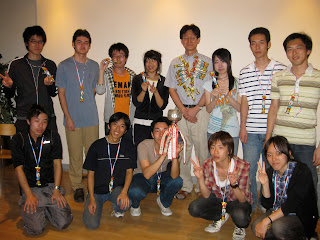2009年10月31日土曜日
2009年10月29日木曜日
2009年10月1日木曜日
新学術領域研究(配位プログラム)がスタート
文部科学省の科学研究費-新学術領域研究「配位プログラム」が発足しました。本領域にて、山元教授が計画班の班長を務め、5年間の研究プロジェクト「超分子プログラミングによるエネルギー・化学変換システム構築」がスタートします。
2009年9月19日土曜日
慶應義塾大学化学科ソフトボール大会で優勝
毎年恒例の慶應義塾大学理工学部化学科ソフトボール大会にて、山元研がみごと優勝を飾りました。昨年の雨天中止を挟んで3年ぶりの栄冠です。MVPにはなんと山元教授が選ばれました(打率.667, 打点16)。
2009年8月27日木曜日
超分子研究会若手懇談会を主催
超分子研究会の若手部会である若手懇談会を、本年は当研究室が担当となり主催しました。高田十志和先生(東工大)、木村睦先生(信州大)、吉沢道人先生(東工大資源研)、根岸雄一先生(東京理科大)、山田真実先生(東京農工大)を講師にお招きし、講演会を開催しました。
2009年7月27日月曜日
C & En News 「Smaller Is Better」
Nature Chemistryに掲載された研究成果が、アメリカ化学会(ACS)の化学情報雑誌であるChemical & Engineering News (C&En News)にて取り上げられました。
ラベル:
Achievement,
Highlight,
News,
Press
2009年7月24日金曜日
2009年7月20日月曜日
Chemistry World 「Fuel cell catalysts go sub-nano」
Nature Chemistryに掲載された研究成果がイギリス王立化学会(RSC)の情報サイトChemistry Worldにて取り上げられました。
ラベル:
Achievement,
Highlight,
News,
Press
Size-specific catalytic activity of platinum clusters enhances oxygen reduction reactions

K. Yamamoto, T. Imaoka, W. Chun, O. Enoki, H. Katoh, M. Takenaga, A. Sonoi
Nature Chem. 2009, 1, 397-402.
Colloidal platinum nanoparticles with diameters of 2–5 nm on carbon supports are currently regarded as the best catalysts for the oxygen reduction reaction. However, the particle size is limited by the conventional preparation methods that are used to synthesize small platinum particles; the inherent activity of ultrasmall nanoparticles has not yet been revealed. We present a practical synthesis for ultrafine subnanometre platinum clusters using a spherical macromolecular template with no disorder in molecular weight or structure. The template, a phenylazomethine dendrimer, offers control of the number of metal complexes in an assembly through stepwise complexation, allowing the complexes to accumulate in discrete nano-cages. Subsequent reduction of Pt(IV) chloride to Pt(0) results in the formation of platinum clusters composed of a defined number of atoms. As a result of exceptionally small particle size, the clusters exhibit very high catalytic activity for the four-electron reduction of oxygen molecules.
ラベル:
Paper_function,
Paper_synthesis,
Papers
2009年6月1日月曜日
日本化学会第89春季年会にて優秀講演賞(産業)
当研究室の後期博士課程2年アルブレヒト建君が2009年3月に行われた日本化学会第89春季年会にて優秀講演賞(産業)を受賞しました。学生講演賞に引き続いての受賞です。
2009年5月12日火曜日
日本化学会第89春季年会にて学生講演賞を受賞
当研究室の後期博士課程2年アルブレヒト建君と越智庸介君が2009年3月に行われた日本化学会第89春季年会にて学生講演賞を受賞しました。当研究室から2件の受賞です。
2009年4月1日水曜日
2009年1月28日水曜日
Dendritic Structure Having a Potential Gradient: New Synthesis and Properties of Carbazole Dendrimers

K. Albrecht, K. Yamamoto
J. Am. Chem. Soc. 2009, 131, 2244-2251.
Dendritic Structure Having a Potential Gradient: New Synthesis and Properties of Carbazole Dendrimers
A new synthetic route for carbazole dendrimers was discovered using the copper-catalyzed N-arylation reaction. This synthetic route allowed synthesizing the fourth generation carbazole dendrimer and several derivatives for the first time. The crystal structure, Mark−Houwink−Sakurada plots, and UV−vis and fluorescence studies showed that the dendritic carbazole backbone has a rigid and highly twisted structure. From the measurement of the redox potential of the ferrocene derivatives, the IR spectra of the benzophenone derivatives, and complexation behavior of the phenylazomethine derivatives, the inductive electron-withdrawing effect of the carbazole dendron was revealed. This suggested that the summation of this electron withdrawal from each layer may produce a potential gradient such that the outer layer is electron-rich and the inner layer is electron-poor in the carbazole dendron. By assignment of the 1H and 13C NMR spectra of the dendron, the existence of this kind of potential gradient was proved. Overall, these data show the π-polarization substituent effect of the carbazole unit, and their summation determines the potential gradient in the repeating dendritic structure of the carbazole dendrimer.
登録:
コメント (Atom)
















